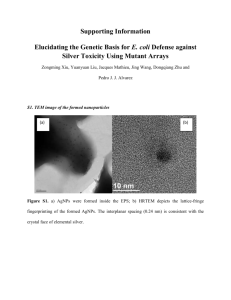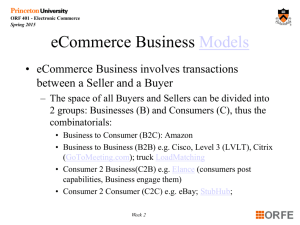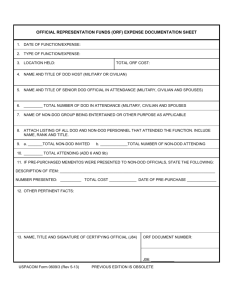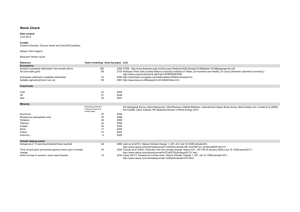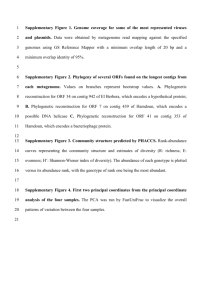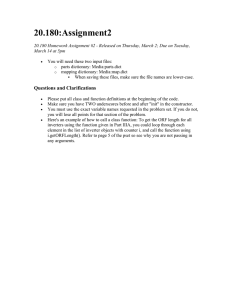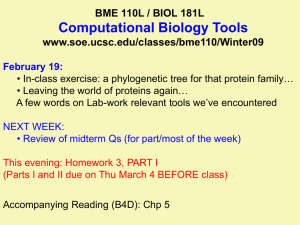Kristen Belanger February 16, 2009
advertisement
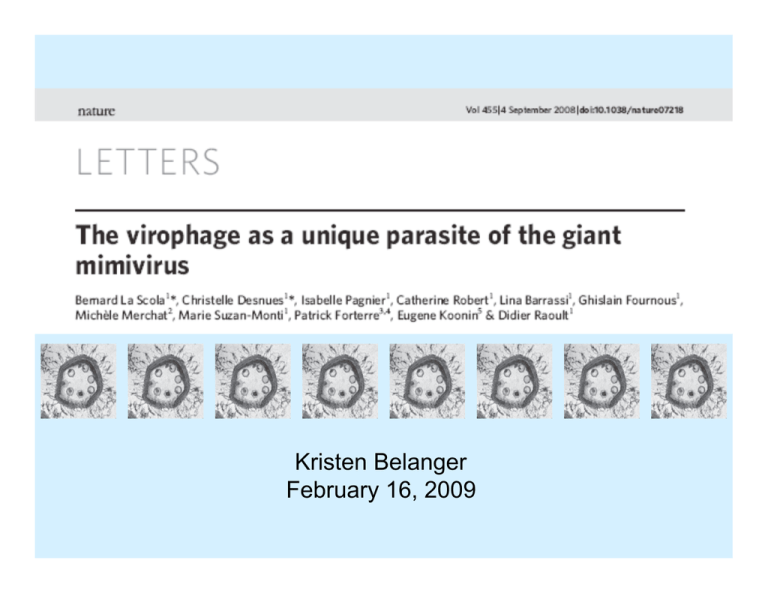
Kristen Belanger February 16, 2009 Acanthamoeba polyphaga • One of a group of free-living amoebae that can be found in a variety of environments -soil, seawater, dust, vegetation, airconditioning units, swimming pools • Amphizoic amoebae: can survive freely in nature, or inside mammalian hosts Acanthamoeba polyphaga Mimivirus • Mimicking microbe • Very large, mature viral particles are 400nm • Unenveloped, icosahedral capsid -multilayered membrane • 80nm fibrils attached to the capsid • dsDNA linear genome, 1.2 Mbp in size Giant Virus La Scola, B, et al. A Giant Virus in Amoebae 10.1126/science.1081867 APMV viral particles and viral factory Raoult, D. et al. Redefining viruses: lessons from Mimivirus doi:10.1038/nrmicro1858 Sputnik invades APMV viral factories and viral particles La Scola, B. et al. The virophage as a unique parasite of the giant mimivirus doi:10.1038/nature07218 Sputnik propagation in Mamavirusinfected amoebae La Scola, B. et al. The virophage as a unique parasite of the giant mimivirus doi:10.1038/nature07218 Presence of Sputnik does not affect Mamavirus Multiplication Cycle La Scola, B. et al. The virophage as a unique parasite of the giant mimivirus doi:10.1038/nature07218 Sputnik causes production of defective Mamavirus particles La Scola, B. et al. The virophage as a unique parasite of the giant mimivirus doi:10.1038/nature07218 Abnormal Mamavirus Particles have Decreased Pathogenicity La Scola, B. et al. The virophage as a unique parasite of the giant mimivirus doi:10.1038/nature07218 ORF Homology ORF Homologues Blue = Mamavirus/Mimivirus Green = NCLDV’s and Bacteriophage Red = Archaeal virus gene Gray = ORFan Purple = Virion protein coding sequences La Scola, B. et al. The virophage as a unique parasite of the giant mimivirus doi:10.1038/nature07218 La Scola, B. et al. The virophage as a unique parasite of the giant mimivirus doi:10.1038/nature07218 Gene (size, amino-acid residues) Closest homologue in GenBank nr Domain architecture/protein family/predicted activity Predicted function in virophage replication ORF 1 (144) – Unknown Unknown ORF 2 (114) – Unknown Unknown ORF 3 (245) RecA-superfamily ATPases (Actinobacillus pleuropneumoniae serovar 1 str. 4074) FtsK–HerA superfamily ATPase DNA packaging ORF 4 (139) Limited similarity to diverse Zn-ribbon proteins Zn-ribbon-containing protein Transcription regulation? ORF 5 (119) – Unknown Unknown ORF 6 (310) MIMI R196 Collagen triple-helix-repeat-containing protein Protein–protein interactions in factories ORF 7 (236) C1q and tumour necrosis factor related protein 5, mouse Collagen triple-helix-repeat-containing protein Protein–protein interactions in factories ORF 8 (184) – Unknown Minor virion protein ORF 9 (175) – Unknown Unknown ORF 10 (226) Phage integrase family protein (Methanococcus aeolicus Nankai) Tyr recombinase family integrase Integration of virophage into APMV genome? ORF 11 (162) – Unknown Unknown ORF 12 (152) MIMI R546 Unknown Unkown ORF 13 (779) Putative DNA-polymerase or DNA-primase (Lactobacillus phage phiadh) Primase–helicase DNA replication ORF 14 (114) – Zn-ribbon-containing protein Transcription regulation? ORF 15 (109) – Membrane protein Modification of APMV membrane? ORF 16 (130) – Unknown Unknown ORF 17 (88) – IS3 family transposase A protein DNA-binding protein ORF 18 (167) – Unknown Unknown ORF 19 (218) – Unknown Minor virion protein ORF 20 (595) – Unknown Major capsid protein ORF 21 (438) – Unknown Unknown La Scola, B. et al. The virophage as a unique parasite of the giant mimivirus doi:10.1038/nature07218 Acanthamoeba is a Melting Pot • Many amoeba phagocytose bacteria for ‘food’ • Some bacteria can evade digestion by the amoeba and even multiply within them Enteropathogenic E. coli Enterococcus faecalis Salmonella typhimurium Bacillus cereus Huws, S. et al. Interactions of some common pathogenic bacteria with Acanthamoeba polyphaga doi:10.1111/j.1574-6968.2008.01123.x Chicken or the Egg • Did Sputnik and Mimivirus give genes to Acanthamoeba or did they get genes from Acanthamoeba? • Could Mimivirus have been a bacterium at one time? Was Sputnik originally a bacteriophage? Should viruses be considered alive? • Wikipedia: life is a condition that distinguishes organisms from inorganic objects -life is a characteristic of self organizing, self recycling systems consisting of populations of replicators that are capable of mutation, around most of which homeostatic, metabolizing organisms evolve • Webster: life is the period during which something is functional What if? What if Chlamydia trachomatis, an obligate intracellular organism, evolved to no longer have ribosomes?

